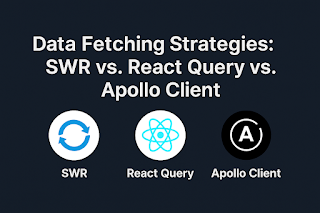Data Fetching Strategies: SWR vs. React Query vs. Apollo Client

In the world of modern front-end development, efficient data fetching is critical to building high-performance, scalable applications. With the rise of frameworks like Next.js and the popularity of SPAs, tools like SWR, React Query, and Apollo Client have emerged as the go-to solutions. But how do they compare, and which one should you use? Let’s break it down. Why You Need a Data Fetching Library While fetch and axios handle the basics, real-world applications need: Caching Background revalidation Pagination Mutation support Optimistic updates Error and loading state management That's where libraries like SWR, React Query, and Apollo Client shine. SWR (Stale-While-Revalidate) From : Vercel Best for : Lightweight apps and static site generation (SSG) Pros: Minimal API and easy to get started Excellent for SSR/SSG in Next.js Automatic revalidation and focus tracking Small bundle size Cons: Limited ...

